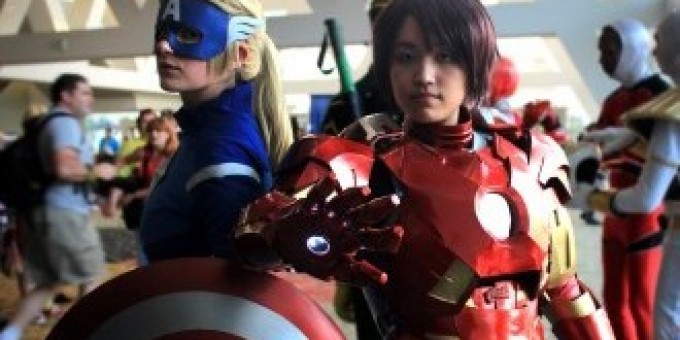
San Diego’s Comic-Con feels like a huge, five-day carnival. Diverse attendees gleefully snap pictures, brave the crowds, and willingly wait in long (sometimes overnight) lines in this annual atmosphere of fantasy, science fiction, geekdom, and celebrity. The creative costumes and the variety of people in them adds to the buzz, and “The Floor” (where comics, games, and other paraphernalia are on display for purchase) pulses with fans who want to meet their artist idols, get autographs, try new games, and fill their swag-bags.
If cosplay (essentially, costuming) is the “face” of Comic-Con, giving it unique features, “The Floor” is more like its body—a massive, complicated space where attendees digest their cultural addiction of choice, whether it be purchasing a Dr. Who bobble-head or a game of Zombie Dice. Despite the dense, hard-to-navigate space of “The Floor”—it can occasionally feel like wading through the zombie-populated terrain of a Walking Dead episode—the space is suffused with a palpable sense of anxious excitement.
San Diego resident and long-time attendee of Comic-Con Melissa Molina describes the atmosphere as full of energy and commotion, noting that what really draws her to the event is “all of the people in the convention center” who “may not all agree on what they like” but who come together in a united devotion to all things Con: comics, science fiction and fantasy films, cult TV shows, video games, fandom culture, and, of course, cosplay.
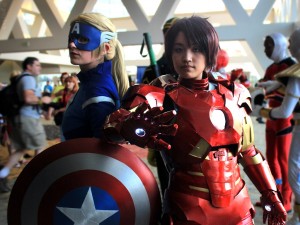
The heady mix of possibilities at such conventions is described as “a megladon shark attacking Godzilla attacking Mothra attacking Tokyo” by blogger Curtis Silver, who notes that “The biggest of these monsters is of course the annual San Diego Comic-Con, where film, television, toys, video games and …comics explode into the pop culture consciousness on an annual basis.” Indeed, the often-quiet convention center oozes people from every door. For the long weekend of the convention, whether on the trolley or in the nearby Gaslamp quarter, one would be hard pressed to go more than 10 minutes without seeing a Con goer wearing one of their tell-tale badges.
There are many positive interactions surrounding the cosplay and nerd culture features of the Con. In lines, strangers become friends, offering water, holding places in line, sharing their passion for Show X or Movie Y. They trade mutual compliments about innovative, creative costumes, and you can see humans of all varieties taking photos of costumed attendees, a practice that is usually filled with appreciation and revelry. As professor Heidi Breuer describes it, the visual presentation gives the Con an atmosphere that allows for positive expressions of geekdom, sexuality, and gender expression.
On her experience as a first-time Con attendee, Breuer writes,
While I agree that Comic-Con allows for at least a partial transcendence of normative performances and expectations surrounding gendered identity, there is still a “masculinist” vibe, as Breuer names it. This sometimes transforms carnivalistic revelry into dehumanizing objectification, predatory gazing, and non-consensual physical interaction. In other words, sexual harassment and assault. Further, though the crowd is diverse in terms of age, race, body-size, and gender (women now make up 40% of attendees), the panels are predominantly made up of males (particularly white, heterosexual males), as is the media produced around the Con. The glaring juxtaposition of free expression and a highly diverse atmosphere against a misogynist, prurient streak that allows for a sophomoric, leering aspect to even everyday activities like standing in line or attending a panel makes Comic-Con a useful case study in terms of changing gender practices and norms.As a feminist, I was a little nervous about what it would be like at the Con … because of the reputation of geek culture as male (or masculinist—with its scantily-clad women with impossible curves) but I really found it to be quite friendly and welcoming…The ubiquitous presence of cosplayers is one of the (many) things that gives the Con a carnivalesque atmosphere in which certain norms about sexuality (such as who can be considered attractive, who ‘should’ wear revealing clothes, or what it means when someone is wearing a sexy costume) can be tested and perhaps temporarily transcended. But, among all of the costumes and scantily-clad women, there also seemed to be a profound acceptance for the ‘non-sexy’ woman, or the awkward geek who does not perform the various rituals of femininity as expected, which added to the welcoming, carnivalesque atmosphere.
Reading Comic-Con as a cultural event that acts as a barometer of gender consciousness (or lack thereof), I argue that though women are now far more present as both producers and consumers at the Con, the representation of females in the media featured still overwhelmingly fits in with normative codes of femininity, particularly in relation to the sexualization of women that frames them as “to-be-looked-at.” Examining the Con in terms of how media production and consumption are both gendered and gendering, I suggest that the lack of representational parity on panels as well as the “male gaze” that dominates the atmosphere is part and parcel of a culture which is still decidedly not post-feminist.
As Comic-Con was envisioned as a “male space” for its first 25-30 years but has become more of a “human space” in the last 10-15 years, it offers an interesting example of shifting ideas about gender and popular culture. While the term “fanboy” used to rule the roost, it is now common to hear “fangirl” or the non-gendered “fandom” when discussing the Con attendees. Some have been critical of the “loss” of this “male space,” complaining in one way or another that “women ruined Comic-Con.” However, the general atmosphere in the last few years has been welcoming of all attendees, not just males. Echoing this acceptance, panel content now includes various woman-centered line-ups, for example, “Women Who Kick Ass,” “Women in Marvel Comics,” “The Witty Women of Steampunk,” “Gender in Comics,” and “The Most Dangerous Women of Comic-Con.” Given that the media Comic-Con features (for instance, games and comics) is still often seen as male, such panels emphasize that women not only star in, but also write, direct, and produce media.
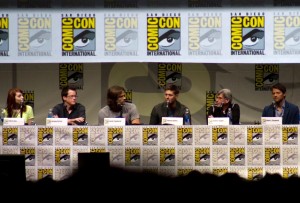
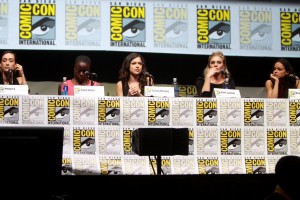
Blogger Dame B discusses the whiplash of gender progress and regressive atmospheres in her piece “The Perfect Feminist Utopia and Comic-Con.” When a friend asks if women panels are “feminist or sexist,” she answers by discussing her imagined “PFU” (Perfect Feminist Utopia), in which “all panels are half male and half female…The characters, the artists, the writers, the fans, the producers and publishers—all half and half. In PFU, a ‘Women in Comics Panel’ would be an interesting panel, no more or less fraught than any other panel topic.” Further, she adds, “there probably wouldn’t be a panel on ‘Women in Marvel.’ It would be too huge of a topic.”
A similar point is made by Holly Derr, who, in her piece for Bitch, suggests that until everyone realizes “the female experience is the human experience,” women will be expected to identify with male characters, panels, and so on. Until this point, Dame B argues, “Women in Comics panels are necessary. They provide a space to discuss the issues associated with being a woman, either as an author, artist, fan, or character. Because we’re such a tiny minority in the artists/writers/characters, it’s a really vital space for having that conversation.”
It is also important to acknowledge that women are no longer at the Con predominantly as “booth babes” but as cosplayers, fans, gamers, volunteers, and staff. This changing landscape comes with some dismay and discomfort—in this, the Con echoes larger societal shifts in gendered norms and expectations that some welcome (feminists, progressives, social justice advocates) and others disdain (conservatives, the religious right, and yes, many male gamers). Why hasn’t the move from hired “booth babe” to active attendee eradicated the sexist dynamics wherein women are framed as passive, objectified bodies to be ogled?
In some ways, the higher concentration of female attendees has heightened such gazing. The Con may no longer be made up of predominantly male fans desirous to “consume” females via comic books, sexualized characters, or booth babes, yet, culture at large still sexualizes girls and women in accordance with the heterosexual male gaze. As such, the often very racy content and costumes of Comic-Con are not aberrant, but they are far more up close and personal. It is one thing to watch Lara Croft on your gaming screen, another to see a near-naked, real-life version of her.
Is it any wonder that the consumers of the media featured at Comic-Cons learn to objectify? Granted, males are also sexualized in such media, but they are often the lead roles. Consumers (especially male ones) are encouraged to envision themselves as strong, muscular, weapon-wielding heroes. Female characters and female consumers are, conversely, more often encouraged to view themselves as desirable, able to trade on sexuality to get ahead in a game or in a fictional world. Sure, there are many “action heroines,” but they are not near as common as the busty comic book vixen or the gaming character whose “armor” leaves her nearly naked.
Harassment is such an enduring concern that various organizations now work with Cons to include anti-harrassment policies. And the sexualization aspect of the Con is redolent both at the level of the “big business” aspects of the event—the film, TV, celebrity, and merchandise promotions – as well as the individual level. While flaunting one’s love of geek culture takes various forms, the atmosphere can makes an attendee feel more like a jostled piece of meat than a fun-loving fan at a comic carnival.
Misogyny is as common as Storm Trooper costumes at the Con. In lines, one is forced to listen to sexist banter, jokes about “tapping that,” and egregious uses of the term “raped” as a supposedly innocuous verb ( “Dude, I totally raped that sandwich”). As an example, at the 2013 San Diego Comic-Con I was in line for Hall H (where all the biggest and most buzzed about panels take place) with my 14 year-old-daughter. Two very tall white men were behind us, encroaching on our space more and more. Immune to my suggestion that they were practically in our laps, one man proceeded to start bragging about the pee bag he had taped to his leg so he didn’t have to leave the line. Then he moved on to complaining about his bad luck with women (apparently they are all “such bitches”). And really, what woman doesn’t want to date a nice fella with some urine strapped to his leg? Yes, I could choose to leave the line or even leave the Con altogether, but removing women’s opportunities to prevent their victimization is an abhorrent excuse for a policy.Why, would these men feel so comfortable displaying such sophomoric, sexist behavior, particularly in front of a child? Because the culture at large presents this as acceptable and natural—even desirable. We live in a “rape culture” that defines women as objects of sexual conquest rather than as sexual agents. These aspects of society infiltrate Comic-Con to such a degree that the blogger who frames the con as “one big Hollywood tease” probably doesn’t recognize the sexist, gender normative undertones of that metaphor. Likewise, when panelists discuss sexism in the industry, there is little patience for the topic. As noted at the blog Geeks Out, male attendees salivate over just about everything at the Con “unless it’s about sexism. Unless it has even a whiff of feminism. Then, it’s GAME OVER.”
Notable examples of the intolerance for “lady topics” have occurred at the “Women Who Kick Ass” panels in recent years. The terms such as “white male privilege” and “destructive male culture” were employed by the likes of Danai Gurira and Michelle Rodriguez in 2013. Apparently, such discussion upset the “Hall H brohive” (as its defined here). The female panelists’ searing stories of sexism in the industry made many in the audience squirm and grumble sexist comments. One man, presumably suggesting a more apt title for the panel, shouted out, “Women who talk too much!” If audience members in Hall H would be so rude to a panel of smart and accomplished women in the fields and media they claim to love, just imagine what happens to the non-famous females in attendance.
Feeling like a piece of meat at Comic-Con isn’t always metaphorical. In 2013, zombie-related costumes proliferated, likely due to the popularity of AMCs The Walking Dead, Max Brook’s WWZ, and popular games/comics such as Lollipop Chainsaw).One young woman’s costume was particularly evocative: she wore a tight tank top and very short shorts—nothing unique in San Diego—but turned her attire interesting with a subtext of political commentary. She’d used fake blood to write “Slutty Victim” across her tank top. The cursive claim called to mind the rape culture in which we reside, in which women supposedly “ask for it”; the media landscape in which women are reduced to stock types including “ice queen” and “slutty victim”; and the Comic-Con culture, wherein some attendees feel entitled to ogle and, in some cases, sexually harass and/or assault women. Whether the woman I spotted meant her shirt as a feminist statement, I can’t know. But, to me, it brought to mind the reclamation of the term “slut” (as with the Slutwalk movement) and the many activist events and organizations that seek to critique patriarchal perpetuations of the woman as a sex object without sexual agency.
While all attendees must jostle for position in the overcrowded and under-stocked convention hall, females have a harder time of it. It’s not just the snaking lines for restrooms, it’s the constant barrage of “sexy,” scantily clad female bodies. From billboards to movies, games, and comics, these images transmit the message the female body is up for judgment and for sale. And, indeed, at Comic-Con, it is—one can pay for pictures with cosplayers and “booth babes”; buy miniature, buxom vixens; and procur comics featuring everything from hyper-sexualized female villains to infantilized, animalized sexpots and girlish characters whose presentation borders on child pornography.
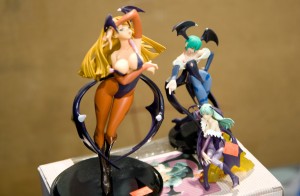
As writer and director Joss Whedon’s body of work and various responses to it attest, there is no “norm” in place for a female hero, especially one who isn’t sexed to the hilt. During a “Dark Horse” panel at the 2011 Comic-Con, Whedon complained that he had been coming to San Diego for 10 years, but had yet to find a female hero statue he could purchase that didn’t look like a porn star. When Whedon went on to describe the story of his career as depicting women who are not helpless, I was reminded of the “Zombie Dice” game I encountered on the exhibit floor in 2011. There were separate characters for “action hero” and “girlfriend.” When I asked the man demonstrating the game why the “girlfriend” couldn’t be an action hero too, he said, “Oh, it gets worse: he has two brains and she only has one.” He continued, “but it’s okay because they save each other.” Too bad that the creator of this game didn’t take a page from Whedon’s book to create a woman with enough brains to save herself!
Alas, I may be waiting a while to see gender-equitable panels and a Con devoid of women treated as “slutty victims,” but until then I will revel in the Con’s more enjoyable aspects while keeping a critical eye on those areas in dire need of improvement. Who knows, maybe a Con in the near future will be the one where Whedon finds a non-pornified female hero statue!
Recommended Readings
Melissa McEwan. 2009. “Rape Culture 101,” Shakesville. Defines and documents the extent to which rape culture pervades pop culture.
Angela McRobbie. 2004. “Post Feminism and Popular Culture,” in Liesbet van Zoonen (ed.), Feminist Media Studies. Thousand Oaks, CA: SAGE Publications. Characterizes the pop culture of the 1990s as a setback in feminism that has not yet been regained.
Laura Mulvey. 1973. “Visual Pleasure and the Narrative Cinema,” Screen 16(3):6-18. This oft-cited film studies piece introduces the concept of the “male gaze.”
K.L. Pereira. 2006. “The Strange History of Wonder Woman,” Bitch: Feminist Response to Pop Culture. Explores the creation of the first female superhero to hit the comics. See also Lillian S. Robinson’s Wonder Women: Feminisms and Superheroes (Routledge, 2004).
John Scalzi. 2012. “Straight White Male: The Lowest Difficulty Setting There Is,” Whatever: Lost in Pacific Time. A New York Times bestselling author’s humorous essay using role-playing games to look at privilege and intersectionality.

Comments